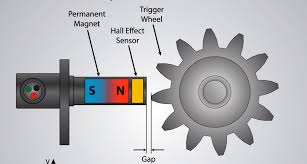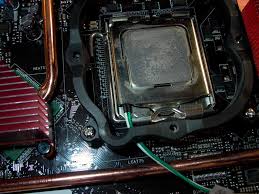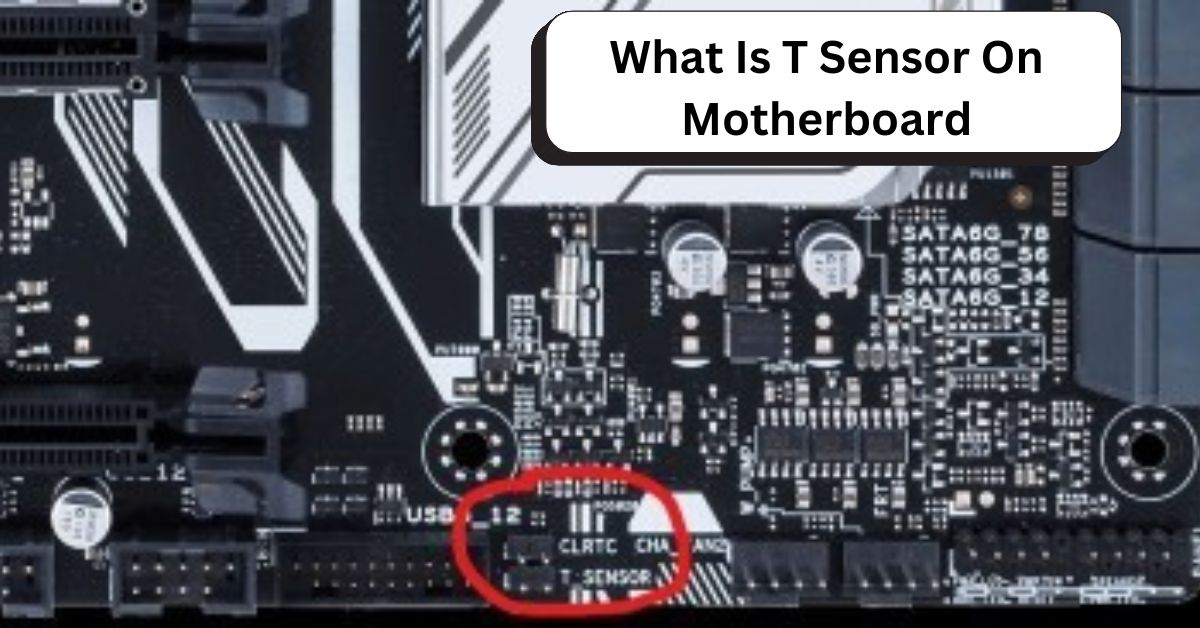The T Sensor on a motherboard is a crucial component that helps monitor the temperature of various hardware parts in your computer. It ensures that your system runs smoothly and prevents overheating.
A T sensor on a motherboard measures the temperature inside your computer. It helps in monitoring heat levels, ensuring the system doesn’t overheat. This sensor is crucial for keeping your PC running smoothly and safely.
In this article, we will discuss “What Is T Sensor On Motherboard”.
Table of Contents
What Is a T Sensor?
Definition:
A T Sensor, or temperature sensor, measures the temperature of various components within your motherboard. It’s a small device that ensures your computer’s internal parts don’t get too hot.
Function:
The T Sensor continuously checks the temperature and sends this data to your computer’s BIOS or UEFI system, which helps regulate fan speeds and other cooling mechanisms.
Types of T Sensors:
Built-in vs. External:
Built-in T Sensors are integrated into the motherboard and measure the temperature of internal components. External sensors, on the other hand, are separate and can be placed in different parts of your computer case to monitor various areas.
Analog vs. Digital:
Analog sensors provide a continuous voltage signal that correlates with temperature changes. Digital sensors, however, give a direct digital readout of the temperature, which is often more accurate.
How Does a T Sensor Work?

Sensing Mechanism:
A T Sensor typically uses thermistors or RTDs (Resistance Temperature Detectors) to measure temperature. These sensors change their resistance based on temperature changes, which is then converted into a temperature reading.
Data Transmission:
The data collected by the T Sensor is transmitted to the motherboard’s chipset. This information is used to adjust cooling mechanisms, like fans, to prevent overheating.
Read: Acer Aspire Xc-603g Motherboard Jumper Pinout – Complete Guide – 2024!
Importance of T Sensors in Motherboards:
Preventing Overheating:
One of the primary roles of T Sensors is to prevent your computer from overheating. By monitoring temperature, they ensure that fans and cooling systems are activated when necessary.
Enhancing System Stability:
Stable temperature levels contribute to overall system stability. Overheating can cause hardware components to malfunction, leading to system crashes or reduced performance.
Read: Acer Aspire Xc-603g Motherboard Jumper Pinout – Complete Guide – 2024!
T Sensor Placement on the Motherboard:
Common Locations:
T Sensors are usually placed near critical components like the CPU or GPU to monitor their temperatures closely. Some motherboards have multiple sensors to provide a comprehensive temperature overview.
Impact on Accuracy:
The placement of the T Sensor can affect its accuracy. Sensors positioned too close or too far from the component may not give precise readings.
Reading Temperature Data:
BIOS/UEFI Interface:
You can check the temperature data from T Sensors through your computer’s BIOS or UEFI settings. This interface provides real-time temperature readings and allows you to adjust fan speeds.
Software Tools:
Various software tools, such as HWMonitor or Core Temp, can also display temperature readings from T Sensors, providing more detailed information and logging capabilities.
Read: Acer Aspire Xc 603g Motherboard Tx1 Pinout – A Guide of 2024!
Common Issues with T Sensors:
Calibration Problems:
Sometimes T Sensors can become uncalibrated, leading to inaccurate readings. Regular calibration checks are essential to maintain accuracy.
Sensor Failures:
T Sensors, like any other electronic component, can fail. If your computer is experiencing unexplained temperature issues, it might be due to a faulty sensor.
Read: Should I Connect HDMI To GPU Or Motherboard – Guide Of 2024
Troubleshooting T Sensor Issues:
Checking Connections:
Ensure that all connections to the T Sensor are secure. Loose connections can cause inaccurate readings or sensor malfunctions.
Replacing Faulty Sensors:
If a sensor is faulty, replacing it is often the best solution. Consult your motherboard’s manual or manufacturer for guidance on replacing T Sensors.
T Sensors and System Performance:
Impact on CPU and GPU:
Effective temperature monitoring helps maintain optimal performance levels for your CPU and GPU. Overheating can throttle performance and reduce lifespan.
Effect on Overall Performance:
A well-functioning T Sensor ensures that your system remains stable and performs efficiently by managing temperatures and preventing overheating.
Read: Can A Motherboard Fit In Any Case – A Ultimate Guide of 2024!
Upgrading and Maintaining T Sensors:
When to Upgrade:
Consider upgrading your T Sensors if you notice persistent temperature issues or if you’re upgrading to more powerful hardware that generates more heat.
Regular Maintenance Tips:
Regularly check and clean your sensors and cooling systems to ensure accurate temperature readings and optimal performance.
Read: What Is Motherboard Red Light – A Ultimate Guide Of 2024!
Comparing T Sensors with Other Temperature Monitoring Methods:
Thermocouples:
Thermocouples are another type of temperature sensor used in some systems. They work well for high-temperature measurements but are less common in consumer PCs.
Infrared Sensors:
Infrared sensors can measure temperature without direct contact. They’re used in some advanced systems but are not as common in standard motherboards.
The Future of T Sensors in Computing:
Emerging Technologies:
Future T Sensors may incorporate advanced materials and technologies to improve accuracy and response times.
Innovations in Sensor Technology:
Innovations such as wireless sensors and integrated thermal management systems are likely to enhance how temperature is monitored and managed in the future.
Where To Place Motherboard Thermistor?

Place the thermistor close to the CPU or GPU for accurate readings. These components generate the most heat, so positioning the thermistor nearby ensures you monitor the most critical temperature areas on your motherboard.
Where Do You Put The Temperature Sensor On A Motherboard?
Attach the temperature sensor near the CPU or GPU, as these areas produce significant heat. Proper placement ensures accurate monitoring of your system’s most critical components, helping to maintain optimal performance and prevent overheating issues.
Where To Plug A Temperature Sensor On A Motherboard?
Plug the temperature sensor into the “T_SENSOR” header on the motherboard. This header is specifically designed for external sensors, allowing you to monitor temperatures accurately and adjust cooling settings based on real-time data.
What Is T Sensor On Motherboard Msi?
The T Sensor on an MSI motherboard is a feature that allows users to connect an external temperature sensor. This sensor provides real-time temperature data, helping users manage system cooling more effectively and prevent overheating.
What Is T Sensor On Motherboard Dell?
On Dell motherboards, the T Sensor refers to an external temperature sensor that monitors heat levels in critical areas. This data helps the system adjust cooling mechanisms to maintain optimal performance and prevent overheating during heavy usage.
Thermal Sensor Connector Motherboard?
The thermal sensor connector on a motherboard is a dedicated header where you attach temperature sensors. These sensors monitor heat levels in real-time, allowing the system to adjust cooling solutions and maintain stable operating conditions under various loads.
“T0” Temp Sensor 72-76c?
A “t0” temperature sensor reading of 72-76°C indicates moderate to high heat, likely from the CPU or GPU. This temperature range suggests that the system is under significant load and may need better cooling to avoid overheating.
Read: Dram Light On Motherboard – Resolve DRAM light error – 2024!
T-Sensor On Maximus Hero Vii?
The T-Sensor on the Maximus Hero VII motherboard is used to monitor temperature via an external sensor. This feature helps users keep track of heat levels in specific areas, ensuring that the system runs efficiently and stays cool.
What Does The Temperature Sensor Do?
A temperature sensor measures the heat generated by components like the CPU or GPU. It provides real-time data that the system uses to adjust fan speeds and cooling solutions, ensuring that components stay within safe operating temperatures.
Thermal Sensor What Is It Electronically?
Electronically, a thermal sensor detects temperature changes in a system and converts them into electrical signals. These signals are then used by the system to monitor and manage temperatures, ensuring optimal performance and preventing overheating.
What Is T Sen1 And Why Is It So Hot?
T SEN1 is a specific temperature sensor on your motherboard. If it’s hot, it likely monitors a component generating significant heat, like the CPU. High readings suggest that the system is under load and needs efficient cooling.
Motherboard Temperature Sensor Location?
Motherboard temperature sensors are usually placed near the CPU, GPU, or voltage regulator modules (VRMs). These areas generate the most heat, so positioning sensors here ensures accurate monitoring and helps maintain stable system performance under various conditions.
2 Pin Temperature Sensor Motherboard?
A 2-pin temperature sensor connects to a designated header on the motherboard. It monitors heat levels in critical areas, providing data that the system uses to adjust cooling and maintain safe operating temperatures during different levels of activity.
T-Sensor Asus Motherboard?
On Asus motherboards, the T-Sensor feature allows you to connect an external temperature sensor. This sensor monitors specific heat-generating areas, providing data that helps the system manage cooling more effectively and prevent overheating during high-performance tasks.
Asus Thermal Sensor Cable?

The Asus thermal sensor cable is used to connect an external temperature sensor to the motherboard. This cable enables the sensor to relay real-time temperature data, helping the system adjust cooling solutions to maintain safe and efficient operation.
FAQs:
What is the main function of a T Sensor on a motherboard?
A T Sensor monitors the temperature of internal components to prevent overheating and ensure stable performance.
How can I check the temperature readings from my T Sensor?
You can check temperature readings through the BIOS/UEFI interface or using software tools like HWMonitor.
What should I do if my T Sensor is not providing accurate readings?
Check connections for looseness and consider calibrating or replacing the sensor if necessary.
Are T Sensors and thermocouples the same?
No, they are different types of temperature sensors. Thermocouples are used for high temperatures and are less common in consumer PCs.
How often should I maintain or upgrade my T Sensor?
Regular maintenance is recommended, especially if you notice temperature issues. Upgrading may be necessary with hardware changes or persistent problems.
Conclusion:
The T Sensor on a motherboard is essential for monitoring the temperature of critical components like the CPU and GPU. By keeping track of heat levels, it helps prevent overheating and ensures your computer runs smoothly and efficiently. Proper placement and regular maintenance of the T Sensor are important for optimal performance and system stability.
I have 15 years of experience in the PC motherboard industry. I am passionate about helping people understand computer technology and write in a way that’s easy to follow. My expertise ensures that my articles provide valuable insights and practical advice for anyone interested in PC components, regardless of their technical background. My goal is to make complex topics accessible and useful for readers around the world.

[…] What Is T Sensor On Motherboard – A Complete Guide Of 2024! Acer Aspire Xc-603g Motherboard Jumper Pinout – Complete Guide – 2024! Are Asrock Motherboards Good – Comprehensive Guide Of 2024! Can Motherboards Bottleneck -A Comprehensive Guide Of 2024! Are MSI Motherboards Good – Discover MSI’s Quality Now! […]
[…] What Is T Sensor On Motherboard – A Complete Guide Of 2024! Acer Aspire Xc-603g Motherboard Jumper Pinout – Complete Guide – 2024! Are Asrock Motherboards Good – Comprehensive Guide Of 2024! Can Motherboards Bottleneck -A Comprehensive Guide Of 2024! Are MSI Motherboards Good – Discover MSI’s Quality Now! […]
[…] The 3060 Compatible With My Motherboard – A 2024 Guide! What Is T Sensor On Motherboard – A Complete Guide Of 2024! Acer Aspire Xc-603g Motherboard Jumper Pinout – Complete Guide – 2024! Are Asrock […]
[…] Read: What Is T Sensor On Motherboard – A Complete Guide Of 2024! […]